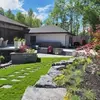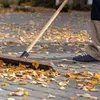HOW TO MAINTAIN A CEDAR HEDGE
- Date : Monday, May 29th, 2023
- Read time : 4 min
Many properties opt for a cedar hedge to optimize the privacy of their yard, delimit certain areas or create screening walls. There are several varieties of cedar on the market, but in Quebec, homeowners tend to opt for western white cedar or black cedar, relatively hardy cedars that are easy to maintain once well rooted. Here are a few tips from our experts on how to maintain your cedar hedge effectively.
First of all, regular maintenance is essential for long-term health and beauty.
TRIMMING YOUR CEDAR HEDGE
We recommend pruning your cedar hedge at least once a year to maintain its shape and density. The best time to prune is usually in spring, before the plant is actively growing. Use clean, sharp garden shears for a clean cut, taking care not to cut too deeply into the wood.
Rather than severely pruning the hedge every year, opt for light, regular pruning. Cut back only excessively long new shoots to encourage branching and hedge density. Avoid trimming branches too close to the trunk, as this can hinder future growth.
Prune the cedar hedge to a regular, uniform shape. Use ropes stretched between stakes as a guide to maintain a straight, even line when pruning. Make sure the base of the hedge is slightly wider than the top to allow even exposure to sunlight.
WATERING AND FERTILIZATION
Cedars need regular watering to maintain their health. Especially when newly planted. Make sure the hedge receives enough water, and be vigilant during dry spells. Deep, slow watering is best, ensuring that the water reaches the roots. Avoid over-watering, as soggy soil can cause problems leading to root rot.
Hedge cedars don't need excessive fertilization. However, a moderate application of fertilizer can promote their growth. Use a balanced fertilizer specially formulated for hedge plants or conifers, following the manufacturer's instructions. Apply fertilizer in spring or autumn.
NOISE
Weeds can compete with cedars for nutrients and water, which can affect their growth. Regularly remove weeds growing near the cedar hedge and use organic mulch around the base of the hedge to help reduce weed growth.
In addition to weeds, insects can also be detrimental to the health of cedars. Keep a close eye on your hedge for pests and diseases such as aphids, mealybugs, rust and branch dieback. If you notice any problems, consult a landscape professional for advice and appropriate control measures.
By following these maintenance tips, you can keep your cedar hedge healthy, attractive and dense all year round. Don't forget to adapt maintenance to the specific conditions of your region, the type of trees that make up your hedge, and to consult experts if necessary.





